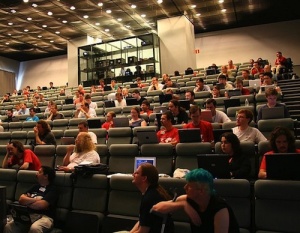Heutagogy
| Foundation Skills | |
|---|---|
| Teaching approaches that support learner-centred education | |
| Pedagogy, Andragogy and Heutagogy | Objectives | Teaching Styles | Pedagogy and Andragogy | Heutagogy | Summary |


One of the key differences between pedagogy and andragogy is that there is a shift from dependency on the teacher towards one where the teacher acts as a facilitator of learning. The learning in an andragogical setting is also more self-directed.
- Heutagogy
- takes this concept further. Kenyon and Hase (2001) describe the need for a new approach to vocational adult education for the 21st Century. In their article: Moving from andragogy to heutagogy in vocational education, they describe a form of self-determined learning called Heutagogy.
In this approach to education, learning is flexible and designed by the learners in negotiation with their teacher who provides some resources and also guidance. Therefore learners are no longer fully dependent on a teacher and are able to learn effectively through a process of learning that they develop. The heutagogical approach can be seen as a progression from pedagogy to andragogy to heutagogy, characterised by an increase in learner control and autonomy and a corresponding decrease in teacher control and course structuring. To a large extent, the learner determines what, how and when to learn.
- Technoheutagogy
- is another approach involving the study of technology to enhance the experience of learner-directed learners. Bill Pelz (2012) explains, very succinctly in a YouTube video clip, the differences between the terms pedagogy, andragogy, heutagogy, and technoheutagogy. Bill Pelz Reflects on the Term Technoheutagogy (1.41 min).
In summary,
- Pedagogy - the art and science of teaching, especially to children;
- Andragogy - the art and science of teaching adult learners;
- Heutagogy - self-determined learning;
- Technoheutagogy - technology-enhanced learner-directed learning environments.
|
For a more in-depth treatment of the subject of heutagogy, you may wish to read Lisa Blaschke's (2012) article Heutagogy and Lifelong Learning: A Review of Heutagogical Practice and Self-Determined Learning. The author explains the differences between andragogy and heutagogy, illustrating how Web 2.0 and social media enable heutagogy. The article also includes course design elements that support learner-centredness in a heutagogical approach.
|
References
- Blaschke, L. (2012). Heutagogy and lifelong learning: A review of heutagogical practice and self-determined learning. The International Review of Research in Open and Distributed Learning, 13(1), 56-71. Retrieved from http://www.irrodl.org/index.php/irrodl/article/view/1076/2087.
- Kenyon, C., & Hase, S. (2001). Moving from andragogy to heutagogy in vocational education. In Research to reality: putting VET research to work. Proceedings of the Australian Vocational Education and Training Research Association (AVETRA) Conference Adelaide, Australia. March 28-30. Retrieved from http://www.avetra.org.au/abstracts_and_papers_2001/Hase-Kenyon_full.pdf